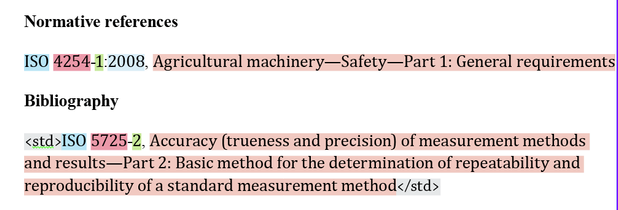Reference Types
Caitlin Gebhard (Unlicensed)
Sylvia Hunter (Unlicensed)
Jenny Seifert (Unlicensed)
eXtyles Bibliographic Reference Processing is very good at restructuring references that already have a decent structure. Your original references may not be in the editorial style that you want; they may not be consistent; they may not even be accurate; but if your references have enough recognizable pieces of information, then eXtyles may be able to do all the tedious restructuring for you. For example, journal article references tend to be rather uniform in structure, and this means that eXtyles does a great job of restructuring and correcting them.
The following table lists the reference types that eXtyles Reference Processing can currently tag and restructure:
*Tagging and restructuring book and book chapter references requires the additional Book Reference Processing module. **Tagging standard references requires the additional Standard Reference Processing module. ***Only references to standards from publishers with known designation formats (e.g., ISO, IEC, EN, BSI, DIN) are reformatted. References to standards from other publishers (e.g., ASTM, IEEE) have their elements color coded (i.e., identified with character styles), but no reformatting is done to avoid introducing errors in designations ****Tagging conference proceeding references requires the additional Conference Reference Processing module.Tag Reference Type Styled/Tagged Restructured <jrn> Journal article Yes Yes <bok> Book Yes* Yes* <edb> Edited book or book chapter Yes* Yes* <std> Standard Yes** Yes*** <conf> Conference proceeding Yes**** No <prpt> Preprint Yes No <eref> Website or online article No No <lgl> Legal case or statute No No <ths> Thesis or dissertation No No <other> Working paper, patent, map, or other document No No <unknown> Unsupported or otherwise unknown reference type No No
On this page
Bibliographic Reference Processing and Validation
- Bibliographic Reference Processing
- Standards Validation
- PubMed Reference Checking & Correction
- Crossref Reference Checking & Correction
- Duplicate Reference Checking
- Reference Sorting
- Journal Database Update
Continue reading
Journal References
eXtyles Reference Processing can restructure most journal references that have no significant author errors with near-perfect accuracy. References that are not restructured are visually identified for manual editing.
After reference processing, a typical journal reference looks like this:

Book and Conference Proceedings
If your configuration of eXtyles also includes the book and conference proceedings processing add-in modules, eXtyles Reference Processing will also automatically process references to books and conferences. After Bibliographic Reference Processing is run, a typical book reference looks like this:

If you do not have the module for book processing, book references are partially processed.
eXtyles identifies the type of non-journal reference and highlights the authors and year. Non-journal references include books as well as references that cite conferences, working papers, unpublished theses, and other works. The following example shows how a typical book reference appears after Bibliographic References processing without the book processing module:

Both the reference type tag (such as <bok>) as well as the lesser degree of color coding can easily be used to identify non-journal references. Only the authors and year will be highlighted. The rest of the reference is not highlighted.
Reference numbers and authors in books, edited books, “other,” and electronic references are cleaned up according to your chosen publication style. Authors in <unknown> references are not altered. No other automatic reformatting is done to non-journal references unless your organization has purchased the book and conference processing feature. All additional editing of non-journal references must be done manually. See the Manual Editing and Reference Reprocessing section for more information.
As a general rule, all non-color-coded reference text must be carefully reviewed and manually edited. Color-coded text should also be reviewed, but with the exception of article titles, which eXtyles does not alter, it probably will not require further editing.
Standard References
If your organization has the standard reference processing module, Bibliographic References processing identifies standard citations that occur as part of a bibliography or non-normative reference list and wraps them in the eXtyles tag <std>, indicating a standard citation.
This module then applies character styles to standard citations. These character styles, which have the prefix “std_”, have several functions. First, they indicate how eXtyles has identified the elements of the citation—for example, the character style “std_publisher” applied to “ISO” (ISO) indicates that eXtyles considered that element of the citation to be the publisher of the corresponding standard. An editor may verify that eXtyles properly identified the citation elements by checking that the correct character styles were applied to each part of the citation. Second, these character styles represent semantic information added to the document that may be used later in processing, such as by the eXtyles Export filter in producing enriched XML. Because the character styles serve as a proxy for tagging, they should not be removed from a document that will be exported to XML; however, they should be edited if they have been incorrectly applied.
After reference processing, typical standard references look like this:
Only references to standards from publishers with known designation formats (e.g., ISO, IEC, EN, BSI, DIN) are reformatted. References to standards from other publishers (e.g., ASTM, IEEE) have their elements color coded (i.e., identified with character styles), but no reformatting is done to avoid introducing errors in designations.
